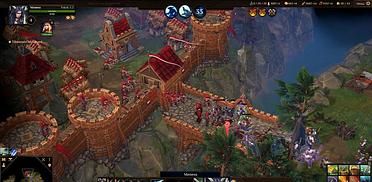Red Barrels brutal social experiment will leave you feeling Saw
The Outlast Trials has made its debut in Early Access, and GameWatcher jumped headfirst into the trials to put together impressions for Red Barrels’ newest horror offering.
I’ve harbored little affection for Red Barrel’s Outlast series. The original game was a decent, albeit chaotic horror title, but its sequel was a disappointment for me - a missed shot that felt more frustrating than fun. It seemed evident (at least, from my perspective) that the series required a significant shift in its design for a successful comeback.
“The Outlast Trials” appears to be that much-needed change. While it retains the core elements of the original, it also introduces a plethora of new features that align much more harmoniously with the game’s ambiance than what Outlast 2 attempted. This feels like the true incarnation of Outlast, and it’s just starting to heat up. In some ways, it should be alarming to see Red Barrels pivot to a co-op focus, but not only does it work in its favor, but it also works just as well as a solo experience.
The plot revolves around a mysterious testing center run by Murkoff, where the sleeper agent program MKUltra is brainwashing any poor soul desperate enough to sign up for it. We are among that unlucky number. To achieve this, each participant must enter into a series of trials and experiments that are designed to strip away their identity and humanity. Once that person has endured enough to make them a malleable shell, they can leave the facility.
My interest in The Outlast Trials was piqued when I heard the developers discuss their inspirations for the game. They referenced films like Saw 2, Cube, and The Manchurian Candidate, in addition to literature such as the CIA Manual of Trickery and Deception and Robert J. Lifton’s Thought Reform and The Psychology of Totalism.
Without experiencing The Outlast Trials first-hand, one could easily dismiss these claims as mere chatter. Based on my prior experiences with the series, I would have been skeptical about the successful integration of these influences into the game. It’s seldom a direct translation from inspiration to implementation, but as you delve into The Outlast Trials, you can discern a considerable measure of these influences - and more - in both the gameplay and the unfolding narrative.
As this is an Outlast game, anticipate that these trials will revolve around gruesome events - which occur quite frequently. One of the initial experiences your character undergoes is having night vision goggles drilled into their skull. While I understand the convenience of having them permanently attached, this may be a slightly excessive interpretation of practicality.
Each level in The Outlast Trials tends to take place on a soundstage within the massive hangars Murkoff dubs ‘Social Worlds’. These are life-size models of real-world environments, and if you never looked too hard or indeed even up, you’d think they were actual environments. But a closer look at the scenery shows the artificial cracks and a glance upwards shows your captors on gangways quietly observing you. In a game full of unsettling things, I don’t think anything beats the sight of being watched like that.
Participants in the trials are given tasks that seem mundane on the surface. Tune radios, turn valves, and things like that. But these come with an extra wrinkle. A wrinkle consisting of a pack of rabid freaks patrolling the play area. One of the things that quickly endeared me to The Outlast Trial’s setup is that it made me think of one of my favorite horror games of all time. Rockstar’s Manhunt was a game ahead of its time, and the meta-commentary on being forced into violence (but not really) has long fascinated me. As did the idea of a protagonist forced to react to a situation they have been entirely coerced into. There’s more than a shred of these things in The Outlast Trials’ makeup, and dare I say it made the entire experience that much better? I do because it did!
The freakish obstacles in your path are more varied than ever. There are the rank-and-file disfigured maniacs, but there is also folk such as the Night Hunter, who is also equipped with the night vision goggles you have. Just more permanently affixed over their eyes. Then there’s the Pusher. A drug-peddling fiend that hits you with doses of psychotropic drugs that alter your perception of reality, and require a race to the antidote if you’re to escape with every limb and organ intact.
Whatever nasty comes up in your trials, there’s always a solution. The Night Hunter is crap in lit areas for instance. You can spot the hiders that sit snug underneath desks and in other pockets of space and veer around them to avoid a savage beating. The beautiful problem comes from the sheer unpredictability of things. You rarely know what threat is around the next corner, and when they start to tag team you, the easygoing on-the-fly reactions don’t quite cut it. Panic sets in and mistakes are made.
Introducing additional players into the game only amplifies the chaos. The intensity of The Outlast Trials varies when played solo, yet it remains incredibly intense in multiplayer mode. One aspect that distinctly stands out when playing The Outlast Trials is its similarity to Saw 2 - my favorite film in the Saw series. The ‘team dynamic’ introduced in Saw 2 serves as a perfect illustration of how most cooperative games unfold in this context.
The most effective aspect of cooperative play in The Outlast Trials is that it doesn’t obligate the team of up to four players to collaborate if they prefer not to. However, the dynamic shift resulting from such a choice is incredibly valuable. Regardless of whether your team effort is an utter fiasco or rivals the prowess of George Clooney and Brad Pitt’s heist crew in Ocean’s Eleven, each participant will experience a personal narrative. It’s a journey that navigates the precarious waters between selfishness and selflessness. The euphoric nature of organic choice introduces a myriad of possible outcomes.
You’re largely defenseless in The Outlast Trials, but not to the same extent you were in the previous games. You can pick up items such as bricks as makeshift weapons to stun would-be attackers, and there is a selection of special additions to choose from that give you a personal boost. These include an echolocation-style system to pinpoint enemies and a set of stun mines you can lay down as a defensive perimeter whilst performing certain tasks. If your group can organize a varied set of tools to bring into a trial, there’s a better chance of being prepared for whatever fresh hell is thrust upon you.
The game does like to twist the knife in just when you think you’ve got it figured out. Especially in co-op. Situations and trials can instill selfish whims in everyone, and there’s delicious drama in just how quickly a good thing can go south.
Red Barrels promises the game will grow and evolve over time, and what it already has in Early Access is convincing proof it can become an even better game than it already is. The Outlast Trials has refreshed the series and set it on a path to potential glory.
Most Anticpated Moment: Watching the drama unfold as your fellow participants try to save their own skin.








